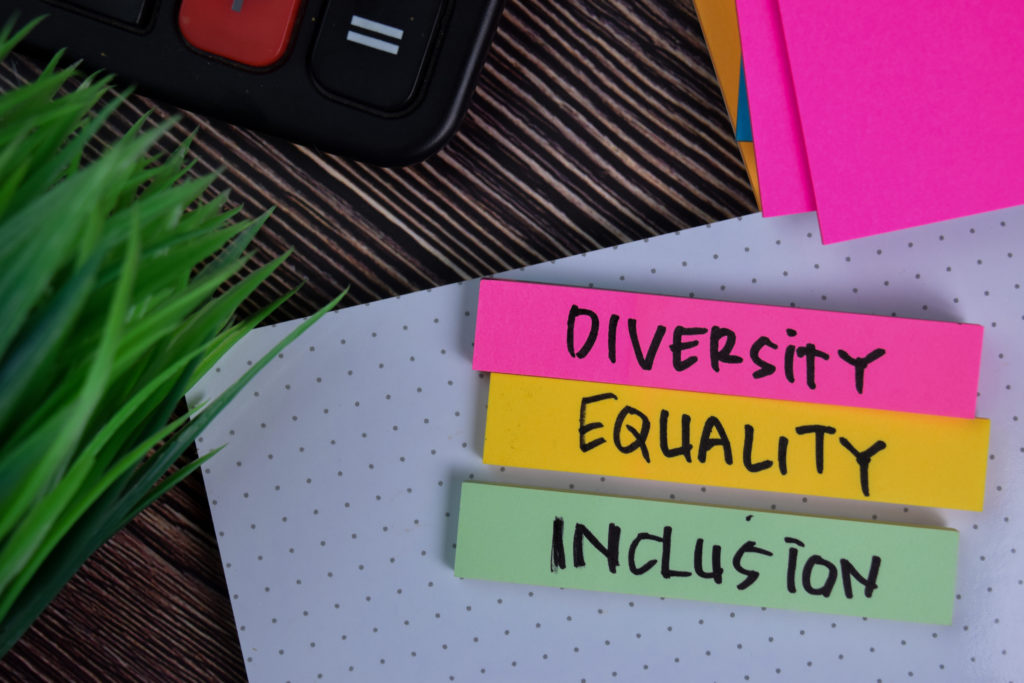
Businesses across the United States are pledging to foster a more inclusive workplace by implementing initiatives that help employees, communities, and regions achieve economic equity.

Commitment to inclusion and diversity is nothing new for Blue Cross Blue Shield of Michigan (BCBSM), now Implementing more than 14 years of their unique Inclusion and Diversity program. Led by Bridget Hurd, vice president of inclusion and diversity, the program continues to build cultural competency and a culture of inclusion throughout the organization through education, awareness, and understanding. As employees become more culturally intelligent, relationships with coworkers improve, and positive collaboration and teamwork across the organization is encouraged. In addition, cultural intelligence is helping Blue Cross employees create meaningful experiences with members and customers.
In 2020, the Diversity and Inclusion department made the transition to the Inclusion and Diversity department. This strategic change was made to emphasize the importance of inclusion when addressing diversity, equality, and equity.
“The program needed to first start at the foundation,” explained Hurd. “We worked to level set to ensure understanding of the terms diversity and inclusion. Once we felt we understood diversity, it was time to move to inclusion.”
Be Inclusive Campaign
The Be Inclusive campaign was initiated three years ago to build an understanding of inclusion – what it looks like and feels like in action. In 2019, all employees made the pledge to Be Inclusive, and in 2020, leaders made the pledge as well. Employees are making a commitment to be inclusive by pledging to:
-
- Consider and respect different experiences and perspectives.
- Not make assumptions based on stereotypes.
- Show respect in interactions with coworkers, customers, and members.
- Develop cultural competency and deepen awareness and understanding of different cultures, communities, generations, and workstyles.
While the learning sessions that are held throughout the year are not required for employees, they are given the opportunity to participate. “Each individual is in a different place in their journey. We recognize and appreciate that. We wouldn’t want to require participation for ongoing learning if they’re not ready,” explained Hurd.

In 2020,
-
- More than 22,800 employees attended over 112 Inclusion and Diversity Learning Sessions.
- More than 5,000 employees attended at least one learning session.
- 2,978 employees joined the Employee Resource Networks (ERN), representing 32% in employee engagement, which is above the national benchmark for ERN involvement.
Other features of Blue Cross’ Inclusion and Diversity program include:
-
- The Diversity Leadership Council.
- 112 learning sessions for employees and leadership.
- Diversity champions for each division.
- 10 employee resource networks to connect on topics and share resources, perspectives, and professional development opportunities.
Community Efforts
Addressing health-related disparities in the community is a key objective of Blue Cross’ strategy. Specific efforts started five years ago with the creation of the Health Care Disparities Action Team.
“Since we do not see patients directly, we asked the question, ‘What can we do to address health and health care disparities as a health plan,’”
The Health Care Disparities Action Team addresses health care delivery and access to quality care within the community. By understanding health and health care disparities in its community, Blue Cross can better serve its members while working to improve social determinants of health.

Health disparities references specific health outcomes in terms of morbidity, mortality, levels of disability, while health care disparities refer to access to health care, the quality of care delivered, access to insurance coverage, and what the insurance covers.
In December 2020, the Office of Health Care Disparities was established to further BCBSM’s commitment by connecting initiatives in the most efficient and effective way possible. The Office of Health Care Disparities focuses on data collection and analytics to understand health and health care disparities in the community. The office is also focusing on behavioral health, chronic disease prevention, and social determinants of health.
“When discussing disparities, we often focus on race and ethnicity,” said Hurd. “Blue Cross is ensuring the conversation also includes the LGBTQ+ community and those with disabilities through education, awareness, and understanding.” Blue Cross joined a list of Michigan businesses that encouraged the amendment of the state’s Elliot-Larson Civil Rights Act to protect lesbian, gay, bisexual, and transgender people.
COVID-19 Response
Throughout the COVID-19 pandemic, Blue Cross has been playing a critical role addressing health and health care disparities. A work group was created to focus on informing and educating community residents about coronavirus in an effort to help decrease morbidity and mortality among African American/Black, Hispanic/Latinx, and Native American communities.

In addition, Hurd was appointed by Gov. Gretchen Whitmer to the Michigan Coronavirus Task Force where she and the team work to improve transparency in reporting data, expand COVID-19 testing, reduce medical bias, and decrease barriers to care.
What should employers be doing to focus more on inclusion and diversity within their organization?
“First, make the commitment to talk about what inclusion and diversity are, what they mean, and why they are important to your organization,” said Hurd. Diversity is different from diversity representation – it is important for employers to work with employees to develop clear definitions of diversity and inclusion.
“Then take the time to understand what may be lacking in your organization,” said Hurd. This can be done through an employee survey or audit. Employers need to remain open to honest feedback so they can move forward with integrating better inclusion into the organization’s culture.
Inclusion and diversity impact everything employees do every day in an organization. “From the moment we develop marketing campaigns and new products, we need to look at them through the inclusion lens,” said Hurd.
Now is the time to join the host of regional businesses who are pledging to foster a more inclusive workplace through initiatives that help employees, communities, and regions achieve economic equity. For more resources and information around achieving economic equity, visit the Detroit Regional Chamber’s Racial Justice and Economic Equity website.